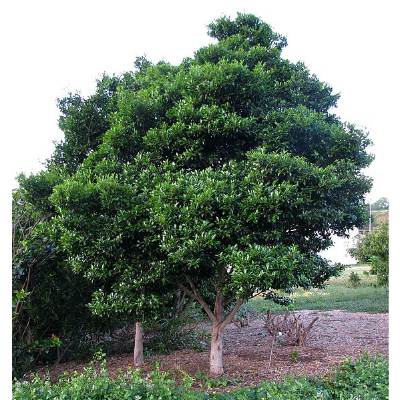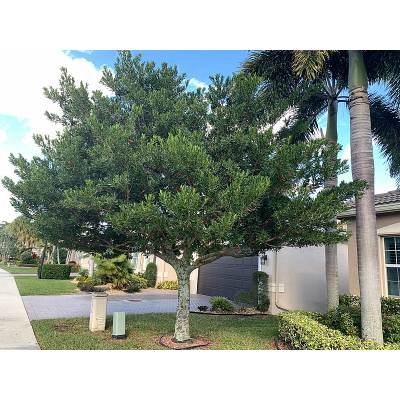Elaeocarpus decipiens, or Japanese Blueberry trees, have been making waves in the Florida landscaping scene. More and more people in the state are using these evergreen conical trees instead of holly trees. Japanese Blueberry trees are becoming popular among homes and landscapers because they look beautiful and can do well in Florida’s climate. Japanese Blueberry trees are a fresh and attractive choice for Florida settings. This piece will go into detail about their benefits and unique traits.
Understanding Japanese Blueberry Trees
E. decipiens Japanese blueberry trees are evergreen trees that are known for their thick, dark green leaves and flexible growth patterns. People in Florida like to use these trees as landscaping because they can do a lot of different things, like line entranceways or give people peace and quiet. They add a bit of class to any home, from a castle-like estate to a cozy house. What makes them stand out is their unique beauty and ability to respond to different conditions. This makes them a great choice for your scenery.
Japanese strawberries are not only pretty to look at, but they are also good for wildlife in the area. They might not be good for people to eat, but deer, birds, bees, and butterflies like them. In the spring and summer, tiny white flowers will bloom, and in the fall and winter, the red leaves will look beautiful against the greenery background.
Characteristics of Japanese Blueberry Trees
The rapid growth rate and enormous height potential of Japanese Blueberry trees are well known. They can grow up to 25 feet tall, which makes them great for making protection walls and bushes. In the spring, they have small white flowers. In the fall and winter, they have dark blue berries that you can’t eat. Japanese Blueberry trees are a great choice for Florida gardens because they look good and are useful at the same time.
To help you better understand the unique characteristics of Japanese Blueberry trees, let’s take a closer look at some key features:
| Characteristic | Description |
|---|---|
| Common Name | Japanese Blueberry Tree |
| Scientific Name | Elaeocarpus decipiens |
| Family Name | Elaeocarpaceae |
| Origin | Japan and China |
| Height | 20′ – 35′ (with the potential to grow to 60′) |
| Width | 10′ – 15′ |
| Growth Rate | Slow to moderate |
| Hardiness Zone | 9B – 11 |
| Growth Rate | Fast-paced growth, reaching up to 25 feet in height. |
| Foliage Color | Lush deep green with occasional bright red leaves. |
| Flowering Season | Small white flowers in spring. |
| Berry Production | Dark blue inedible berries in fall and winter. |
| Adaptability | Thrives in Florida’s climate. |
| Landscape Uses | Privacy screens, hedges, ornamental topiaries, and more. |

Also Read : Grass Types In Florida: Top 8 Picks For Your Lawn
Why Choose Japanese Blueberry Trees for Your Florida Landscape?
Now that we’ve explored the characteristics and care requirements of Japanese Blueberry trees, let’s dive into the reasons why they are an excellent choice for your Florida landscape.
1. Appeal to the eye
Japanese Blueberry trees are beautiful to look at because of their lush green leaves and occasionally bright red ones. They can make your scenery look better by adding to its beauty and giving your outdoor space a nice background.
2. Quick Growth
Japanese Blueberry trees are a great option if you want to quickly block out noise or build a natural wall. Due to their fast growth, you can finish landscaping projects pretty quickly.
3. Being flexible
The adaptability of Japanese Blueberry trees is amazing. You can use these trees for a variety of landscaping purposes, such as protection hedges, decorative topiaries, or just to add some color to your yard.
4. Low Maintenance
Japanese Blueberry trees are relatively low upkeep once they are established, despite the fact that they do require proper care. They are easy for homes and landscapers to use because they don’t get bugs or diseases.
5. Florida Adaptability
The fact that Japanese Blueberry trees can grow in Florida’s temperature may be their best feature for landscaping there. They do best where it is warm and wet, which means they will stay in your open place for a long time.
Japanese Blueberry | 10 Live Trees | Buy Now – Shop from Amazon
Landscaping with Japanese Blueberry Trees

Benefits of Japanese Blueberry Trees in Landscaping
Japanese Blueberry trees offer several benefits when used in landscaping, particularly in Florida:
- Private Screening: These trees are great for making private walls around your property because they have thick leaves. They can keep people and noise out of your outdoor area.
- Low Upkeep: Once established, Japanese Blueberry trees don’t need much care or trimming.
- Aesthetic Appeal: The annual crown and brightly colored leaves make these trees look nice and improve the general beauty of your scenery.
- Adaptability: These trees can grow in a wide range of temperatures and soils, which makes them useful adds to any Florida yard.
Japanese Blueberry Tree Care Guide
To get the most out of Japanese Blueberry trees in your Florida yard, you need to know how to take care of them. If you take good care of these trees, they will grow well and continue to make your area look nice. Here is a complete care guide to help you keep your Japanese Blueberry trees healthy and happy.
Sun and Soil
It’s crucial to put Japanese Blueberry trees in a location that gets plenty of sun all day so they can grow to their full potential. Also, the dirt needs to be able to drain well so that the roots don’t get too wet, which can cause a number of problems. The first thing you need to do to take care of them is make sure they have the right dirt and sunshine.
Watering
Japanese Blueberry trees enjoy constant wetness when it comes to watering. However, once they are established, they can handle some dryness. During the growing season, give them deep waterings less often and let the soil dry out a bit in between. To keep roots from rotting in the winter, water less.
Fertilization
For good growth and leaves, it’s important to use the right fertilizer. You can give the tree the nutrients it needs with a balanced, slow-release fertilizer. For best results, use the fertilizer in the spring and early summer.
Pruning and Trimming
Cutting back and pruning Japanese words To keep their shape and look, blueberry trees need to be pruned. No matter if you want protection screens, bushes, or decorative topiaries, you can prune them to get the shape you want. To encourage new growth, regularly cut off any parts that are dead or broken.
Pests and Diseases
Fortunately, Japanese Blueberry trees are immune to a wide range of diseases and pests. But it’s important to keep an eye on them for any signs of diseases or bugs. If you see any problems, you should talk to a trained landscaper about how to fix them.
Where Does the Japanese Blueberry Tree Come From?
The Japanese Blueberry Tree comes from the beautiful scenery in China and Japan. It does well in the climates of these East Asian countries, and it is slowly making its way into landscaping all over the world. Its beautiful look and ability to grow in a variety of conditions have made it very famous.
How Big Does the Japanese Blueberry Tree Grow?
The Japanese Blueberry Tree’s size can have a big effect on how well it fits in your yard. Knowing what its possible height and width are will help you decide where to put it.
- Height: This tree usually grows to be between 20 and 35 feet tall, but in the right conditions, it has been known to grow as tall as 60 feet. But if you prune it right, you can change its height to fit your landscaping.
- In general, the Japanese Blueberry Tree has a spread of 10 to 15 feet, which makes it a fairly sized tree that can work in a variety of yard settings.
What Is the Growth Rate of the Japanese Blueberry Tree?
The Japanese Blueberry Tree might not be your first choice if you want a tree that grows quickly. People say that this tree grows slowly to moderately, so you’ll need to be patient as it grows. But the wait is well worth it when you see its thick, pretty leaves in full bloom.
Which Climate Zones Are Suitable for the Japanese Blueberry Tree?
One of the best things about the Japanese Blueberry Tree is that it can grow in a variety of climates. It grows best in zones 9B to 11, which makes it a great choice for places with mild winters and warm summers. Great news if you live in one of these temperature zones! This tree will do great in your yard if you take good care of it.
Japanese Blueberry Tree: A Versatile and Low-Maintenance Choice
There are many good reasons to add a Japanese Blueberry Tree to your yard. Because it grows well in a variety of conditions and doesn’t need much care, it’s a great addition to plants of all kinds. There are many things you can use this tree for: as a focus point, a privacy screen, or a beautiful background for your outdoor area.
To sum up, Japanese Blueberry trees are a new and interesting addition to Florida settings. Their unique qualities, ease of care, and ability to thrive in the state’s temperature make them a great choice for homes and landscapers who want to make their outdoor areas look better and work better. Japanese Blueberry trees are a great option if you want peace, good looks, or a lot of different uses. If you live in Florida, you might want to add these beautiful trees to your yard and watch them grow and change the look of your outdoor space.
